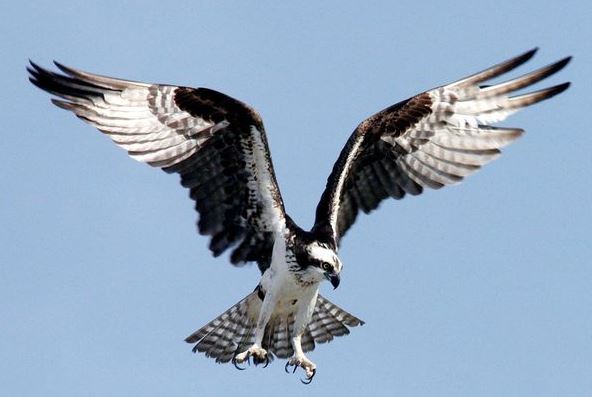"LOOK, it's a bird...wait, it's a plane....wait it's a bald eagle...wait, it's an African fish eagle...wait, it's an osprey!"
Most often mistaken for a bald eagle, the osprey does NOT have an all-white head but instead a 'black mask' through the eyes and down the back of the neck (think Zorro or The Lone Ranger). The osprey is also distinct for having brown bands on its tail, which is an easily noticed difference from the pure white tail of the adult bald eagle.
“Wow, look a bald eagle,” commented a friend as we hiked the shores of Lake Hodges recently.
Perched nearby was huge bird with a striking white chest. It could easily be mistaken for an eagle, but what we were actually seeing was an osprey. Ospreys have a wingspan of nearly 6 feet, compared with the bald eagle’s nearly 7 feet. When perched, the osprey stands about 2 feet tall, with striking gold eyes that give the bird an intense look.
Because of its large size and similar coloration, the osprey is often mistaken for a bald eagle. But unlike the more elusive eagle, the osprey is a somewhat common resident of San Diego lakes, lagoons and bays and seems quite comfortable sharing its home with nearby urban dwellers.
There are regular osprey visitors at Lake Hodges, Oceanside Harbor, the lagoons along the North County coastline.
The osprey can be found here all year but is more numerous during migration and in the winter months when birds have moved south from colder climates.
Because these beautiful hawks feed almost exclusively on fish, they are known in some areas as a fish hawk, river hawk, fish eagle or sea hawk.
Watching an osprey feed is an incredible experience. The huge bird flies gracefully over its watery fishing grounds. With total concentration, he looks for a target, then glides downward and at the last minute extends his talons forward. If a fish is close to the surface, the osprey will grab it and continue forward, climbing slowly with its prize.
Sometimes the birds will actually dive completely under the water feet first and emerge with a small halibut or freshwater bass. As they exit the water, the added weight of the water seems to slow them down, but as they climb skyward, they shake violently to remove the unwanted water.
They are also successful hunters, with studies showing they have a success rate as high as 70 percent, snagging a fish about every 12 minutes. Most Escondido fishermen would love to have that kind of success!
Here is gorgeous video of some Osprey fishing (though not at Lake Hodges):

 RSS Feed
RSS Feed
